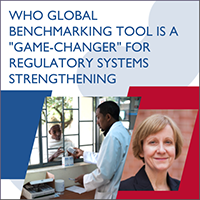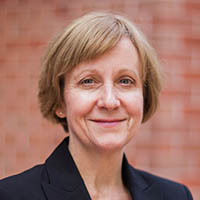WHO Global Benchmarking Tool is a “Game-changer” for Regulatory Systems Strengthening

![]() This blog is part of the blog series “Pharmaceutical Systems in Practice: Global Insights” and was originally posted on the USAID MTaPS Program website.
This blog is part of the blog series “Pharmaceutical Systems in Practice: Global Insights” and was originally posted on the USAID MTaPS Program website.
According to the World Health Organization (WHO), an estimated 1 in 10 pharmaceutical products sold globally is falsified or substandard,¹ with deadly effects and the situation is known to be far worse in certain regions of the world; in 2013 alone, falsified malaria medicines killed more than 120,000 children in Africa.² Meanwhile, WHO surveys in 2018 estimated that only about one-third of National Regulatory Authorities (NRAs) had the capacity to effectively regulate medical products in their hospitals, pharmacies, and communities, with only one of those NRAs being in Africa.
The WHO Global Benchmarking Tool (GBT) is the first globally agreed-upon framework for evaluating the capacity of a national regulatory system. Using the gaps identified in the GBT assessments, countries can develop an institutional development plan that lays out the pathway to strengthen the system. Two USAID programs—Medicines, Technologies, and Pharmaceutical Services (MTaPS) and Promoting the Quality of Medicines Plus (PQM+), which are supporting the use of the GBT in countries—hosted a joint webinar for USAID staff on April 21 to explain how the GBT tool can help countries make comprehensive, sustainable gains that can strengthen their regulatory systems and address the problem of falsified medical products in markets.
“This tool is a ‘game-changer’. It has created a new opportunity for and a renewed interest in regulation by international partners, regulatory agencies, and national governments. Regulation is essential to ensuring access to safe, effective, and quality-assured medical products and promoting their rational use,” said Javier Guzman, Technical Director for USAID MTaPS, who presented on how the program is partnering with WHO, PQM+, and others to implement the GBT.
Identifying Gaps and Setting a Course for Progress
Most USAID-supported countries have weak regulatory systems, stemming from outdated laws, inadequate or no regulations, multiple and sometimes conflicting rules on medicines controls, insufficient infrastructure, fragmented responsibilities, and limited human and financial resources.
Quality-assured medicines that are used safely and effectively are critical to the success of health programs and achieving goals, importantly universal health coverage (UHC) and Sustainable Development Goal (SDG) 3, as well as USAID’s goal of enabling high-performing health care systems.
“A quality health care system is a three-legged stool. You have to have quality practitioners, quality facilities, and quality medical products for those practitioners to use. If any leg is inadequate, you do not have a quality health care system,” said Murray Lumpkin, Deputy Director, Integrated Development, and Lead for Global Regulatory Systems Initiatives at the Bill & Melinda Gates Foundation (BMGF), who joined the webinar as a special guest.
The GBT assesses regulatory system maturity using four levels, from Level 1 (no formal approach) to Level 4 (a sustained international level of performance with systematic continual improvement). More than 260 indicators related to nine broad categories of regulatory functions help regulatory authorities objectively identify strengths and areas for improvement. The GBT also allows countries, donors, and partners to plan for and work toward sustainability in a stepwise manner. Rather than relying on disease-focused or vertical assessments and interventions, it measures the varied system components that must work interoperably to make regulatory activities effective and efficient.
GBT’s Country-Led, Collaborative Approach
The GBT process puts health leaders in the driver’s seat, helping the policy-makers build confidence and self-reliance while supporting flexible, country-specific institutional development plans. “It’s both a tool and a process enabler. It reduces duplication of efforts from development partners and helps conserve resources,” Guzman said.
The four-part process involves country self-benchmarking, followed by a WHO-coordinated observed information audit and field visits. After the assessments, countries take the lead in devising an institutional development plan, prioritizing key activities, and monitoring their own progress. A WHO-led coalition of interested parties (CIP), which is a coordinated effort that involves governments, partner agencies, and others (including USAID, USP through PQM+, MSH through MTaPS, and BMGF) as needed, supports the process throughout.
“The collaborative approach of the CIP is critical. It is a mechanism that really helps the country implement its institutional development plan effectively. It’s a global coordinated effort run by regulatory authority and supported by WHO that is a convening of partners who can contribute to regulatory systems strengthening. When they come together and can understand each other’s areas of expertise, they are better able to focus their efforts,” Jude Nwokike, Director of PQM+, said.
The GBT’s user-friendly computerized mode and online training boost global implementation. It is available in English, French, Spanish, and soon, Russian. So far, it has been applied by regulatory authorities in charge of medicines and vaccines, and it will be expanded to include blood, blood products, medical devices, and diagnostics. To date, 82 countries have completed self- and formal benchmarks, 47 of which are in Africa.
“This gave WHO a database of which countries in sub-Saharan Africa have emergency [regulatory] procedures, and which need to get ready for when they do have products for COVID-19,” Lumpkin noted referring to the current pandemic.
Key Takeaways
- Strong regulatory capacity is an essential component of a well-functioning health care system—a critical path to ensuring access to safe, effective, and quality-assured medical products and innovation within a high-performing health care system.
- Regulatory capacity is an essential public health function and plays a significant role in achieving UHC and SDG 3 (target 3.8).
- The WHO GBT offers a unique opportunity to the global community to help strengthen NRAs by:
- Guiding strategic investments in regulatory systems strengthening
- Promoting good regulatory practices, flexible regulatory frameworks, reliance, collaboration, and networking
- Building and improving trust in medical products and surrounding regulatory systems, which will boost local quality pharmaceutical manufacturing and exports in the region
- Strong regulatory systems save lives!
“When people come and ask about support for regulatory systems capacity building, it’s a question of what capacity, and what standards you are going to use to build this capacity, and to what end, and what metric are you going to use to measure it? Neither USAID nor we (at BMGF) are in the business of funding ad hoc capacity building initiatives. The GBT is a valued tool because it provides a way to answer those fundamental questions before support is offered by funders.” – Murray Lumpkin (BMGF)
“Pharmaceutical Systems in Practice: Global Insights” blog series sheds light on the USAID MTaPS Program’s systems approach to strengthening pharmaceutical systems in LMICs, which is critical to achieving higher-performing health care systems and the global health goals.
¹WHO Global Surveillance and Monitoring System for substandard and falsified medical products, November 2017, World Health Organization. https://www.who.int/medicines/regulation/ssffc/publications/gsms-report-sf/en/
²Estimated under-five deaths associated with poor-quality antimalarials in sub-Saharan Africa, June 2015, The American Society of Tropical Medicine and Hygiene. https://www.ncbi.nlm.nih.gov/pubmed/25897068/
ABOUT THE AUTHOR
 Stacy Lu is a lead writer for MSH, producing news, feature stories, and reports about the organization’s work and results. Prior to coming to MSH, she worked as a consultant for UNICEF at its headquarters in New York for more than a decade as a writer, editor, and web producer, assisting its web team and data reporting unit. An award-winning health journalist, she has written for The New York Times, Forbes.com, ABCNews.com, and NBCNews.com as a staffer or regular freelance contributor. She holds an M.Sc. from the Columbia University Graduate School of Journalism.
Stacy Lu is a lead writer for MSH, producing news, feature stories, and reports about the organization’s work and results. Prior to coming to MSH, she worked as a consultant for UNICEF at its headquarters in New York for more than a decade as a writer, editor, and web producer, assisting its web team and data reporting unit. An award-winning health journalist, she has written for The New York Times, Forbes.com, ABCNews.com, and NBCNews.com as a staffer or regular freelance contributor. She holds an M.Sc. from the Columbia University Graduate School of Journalism.




Responses